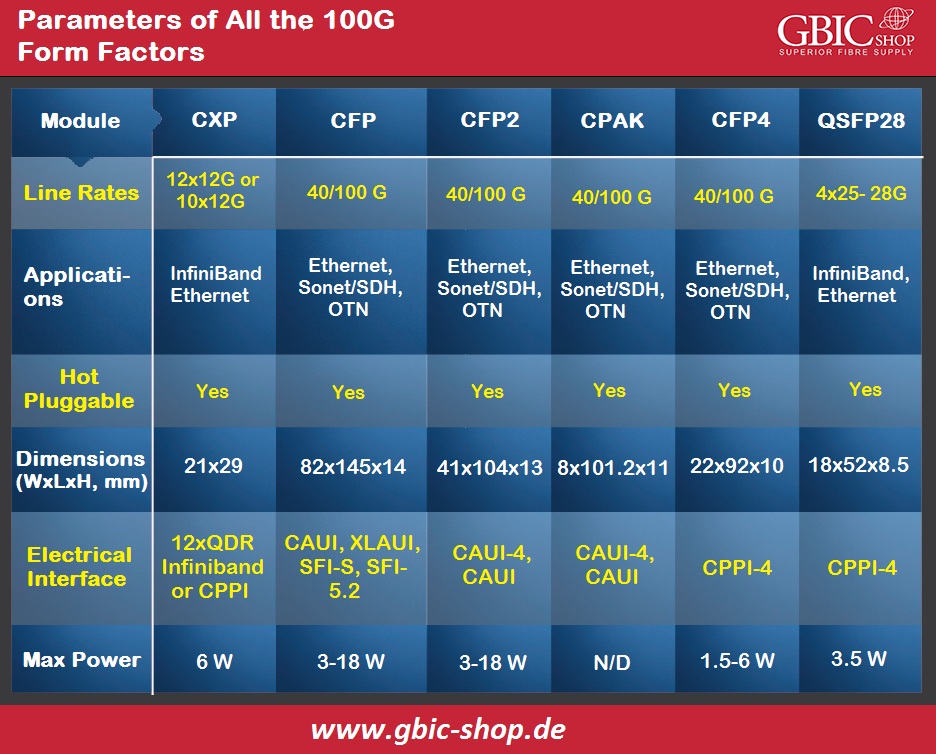The introduction of 100 Gigabit fiber transceivers is pushing 100 Gigabit networks for data centers and enterprises into the current market. Their adoption for short-haul links is developing splendidly, while long-haul 100 Gigabit communications are also growing rapidly, which is significantly driving the need for high-performance, reliable 100 Gigabit optical fiber and technology upgrades. So how will 100-gigabit optical modules and market advances compete with unusual data traffic in the future? Here, we describe the technological development of 100 Gigabit optical transceiver modules and share some current insights about 100 Gigabit fiber transceivers.
Renewal of 100G fiber optic transceiver technology:
The development of 100-gigabit transceivers is minor, high-frequency, and has excellent capacity as cloud services and large data centers have an insatiable demand for network bandwidth. Let's take a look at the advances in 100 Gigabit optical transceiver technology.
Small Form Factor:
We have six main form factors for 100 Gigabit optical transceivers in the market: CFP, CFP2, CFP4, CXP, QSFP28 and CPAK. Among these form factors, the 100 Gigabit QSFP28 optical modules with low power consumption and large compact size are the best 100 Gigabit modules in enterprise and data centers. The following table describes the details of each 100 Gigabit optical transceiver.

Most integrated chips:
The fiber optic transceiver chip is an integrated circuit that transmits and accepts fiber optic data. It is the heart of a fiber optic transceiver and remains a technical hurdle that manufacturers struggle to overcome. Typically, the chip of a fiber optic transceiver is made from unique semiconductor materials. However, the significant use of fiber optic transceivers in networks in certain cloud implementations requires higher optical transceiver performance, long distance communication and advanced modulation. We believe that fiber-optic silicon photonic transceivers can reduce size, increase integration density, and have lower power consumption. 100-gigabit silicon photonics products, including 100-gigabit CWDM4 and 100-gigabit PSM4, are commercially available and enable single-mode transmission. In addition, the implementation of these optical transceivers in cloud applications and data centers will continue to advance.
Simple packing
Compared to other packaging technologies such as box or flip-chip, chip-on-board (COB) is widely used in high-level multimode transceiver modules for 40 Gigabit/100 Gigabit data centers because it enables higher density and smaller form factor. To attach chips or fiber elements to the PCB, COB, a non-hermetic package, uses rubber patch technology. The later gold wire bonding uses an electrical connection, which is then sealed with an adhesive on the top. The biggest advantage of COB packaging is that we automate it and use it for packaging to combine silicon photonics with low cost, less space and less production precision requirements.
The introduction of 100G fiber transceivers is gaining popularity:
Manufacturers of 100 Gigabit fiber transceivers are competing to improve the product and increase its adaptability. The regular deployment of 25GE between servers and top-of-rack switches will force 25GE users to migrate to 100GE. Shipments of 100-Gigabit switch ports will exceed shipments of 40-Gigabit switch ports as 100-Gigabit switches with 25-Gigabit servers become prevalent in large data centers, replacing legacy 40-Gigabit switches and 10-Gigabit servers. The implementation of 100-gigabit optical transceiver modules is developing sustainably and has become the fastest Ethernet connection. In contrast, the market for 40-gigabit switches has seen a rapid decline, while demand for 10-gigabit switches will show a flat trend. We can predict that the adoption of 40 Gigabit is only possible if we cannot use 100 Gigabit due to compatibility, technical issues or low cost. 100 Gigabit fiber modules will continue to gain traction as supply issues are resolved.
.jpg)
A few key users combined with many vendors competing for 100 Gigabit optical transceiver orders will undoubtedly drive down the price of 100 GE optical modules, making the price difference between 40 Gigabit and 100 Gigabit only small.
.jpg)
Conclusion
The rapid development of IT (information technology) data greatly increases the need for high-speed communications and technological advances. For cloud developers and hyper-scale data centers, 100GE is a reasonable bandwidth. Therefore, 200/400GE may be the option that enterprises can plan for the future. It can help you make the decision to purchase 100 Gigabit fiber transceivers or expand your network infrastructure. The knowledge of 100 Gigabit developments and trends provided in this article is for reference.
 English
English
 Deutsch
Deutsch
 Espaniol
Espaniol










